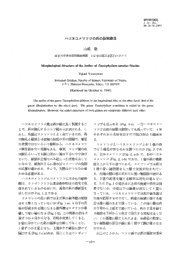
Morphological Structure of the Anther of Tsusiophyllum tanakae Maxim PDF
Preview Morphological Structure of the Anther of Tsusiophyllum tanakae Maxim
植物研究雑誌 J. Jpn. Bot. 66: 35-38 (1991) ハコネコメツツジの菊の裂開構造 山崎敬 東京大学理学部附属植物園 112東京都文京区白山3-7-1 Morphological Structure of the Anther of Tsusiophyllum tanakae Maxim. Takasi YA MAZAKI Botanical Gardens,Fa culty of Science,Un iversity of Tokyo, 3-7-1,H akusan Bunkyoku,To kyo,1 12 JAPAN (Received on October 6,1 990) The anther of the genus Tsusiophyllum dehisces by the longitudinal slits,o n the other hand,th at of the genus Rhododendron by the apical pore. The genus Tsusiophyllum sometimes is united to the genus Rhododendron. However,th e anther-structures of both genera are completely different each other. ハコネコメツツジ属は蔚が縦に長く裂閲するこ ツジでも見られる (Fig.1e). 一方ハコネコメツ ・ とで,蔚が開孔するツツジ属から区別される. し ツジでは菊の隔壁は裂関しても残っていて, 4室 かし,外観はコメツツジとよく似ているため,蔚 それぞれから花粉を出すので開口部は 4個所あ の開孔と縦裂とは裂開の程度の差の問題で,重要 る. な差異ではないという解釈から,ハコネコメツツ コメツツジとハコネコメツツジとが 1個の菊 ジ属を認めない見解もある.事実,ツツジ属の蔚 でどう構造が異なるかを調べたのがFig.2であ は関孔といっても開口部の一端は下方にやや伸び る.左がコメツツジ (Fig.2,a- d)で,右がハコネ ていて,縦裂が上端でのみ起こった状態を示して コメツツジ (Fig.2,e- h)であり, 1個の薪の横断 いるので,縦裂がさらに進めばコメツツジの裂聞 面を上から下に並べてある. コメツツジでは菊は の状態が導かれる.そこで,実際はどうなのか確 1層の厚い細胞膜をもっ層で、全体が包まれてい かめる必要がある. る.先端の開口部の所だけに薄い細胞膜の層があ ハコネコメツツジとコメツツジとは小石川植物 る. 2室の菊室を隔てる隔壁は消失が進んでい 園で, ウンゼンツツジは東京都中野区の自宅で栽 る.ただFig.1の場合ほど上部の隔壁の消失は顕 培されているものを用いた.両者の蔚の横断面を 著でないが,中部以下は隔壁が消失して 1室に 示したのがFig.1,2である. なっている.ハコネコメツツジでは菊の最外層は コメツツジの若い蔚ではまだ菊の最外層の細胞 全体が肥厚するのでなく,薪室の隔壁に接する部 はそう厚くなっていないが(Fig.1-a),4 分子の花 分は薄い層のままで残っている. この薄い層は薪 粉が形成される頃になると最外層はクチクラが蓄 の下部から上部まで続いている.蔚の2室を隔て 積して厚い層になる (Fig.1・b).この時期の蔚は2 る隔壁は下部から上部まで消失する気配は全くな 室ず、つの4室からなる.花粉が成熟してくると, い.この隔壁に隔てられたまま,各菊室の肥厚し 2室に分けていた蔚の隔壁は分解してなくなり, ない細胞層の部分が縦に長く裂けて開口部となる 1室ず、つの2室となり,上端がやや縦長に裂けて のである. 関口する (Fig.1cand d).同じことはウンゼンツ 以上のことから,ツツジ属では蔚の隔壁が消失 ・ -35- 36 植物研究雑誌第66巻第l号 平成3年2月 Fig. 1. Transverse sections of the anthers. a-d; Rhododendron tschonoskii. a,b efore .the tetrad formation of the pollen,s howing the epidermal cell walls not cuticulized. b,a fter the tetrad formation of the pollen,sh owing the epidermal cell walls cuticulized. ca nd d,m ature stage, c,m iddle part of the anther,s howing the separating walls of the pollen sacs degenerated. d, upper part of the anther,s howing each pollen sac with one pore (p). e; Rhododendron seゆ'yll- ifolium,m ature stage of the anther,s howing the separating walls of the pollen sacs degen- erated. f; Tsusiophyllum tanakae,m iddle part of the anther,s howing each pollen sac with separating walls and with two opening slits (s). All ca. X1 3. し蔚室は2室となり,蔚壁は先端の開口のみに細 た最外層で覆われるが,裂関する部分は下から上 胞膜の薄い層ができるだけで,全体は肥厚した外 まで薄い細胞膜の層が残されている. 開口部は4 層で覆われている.ハコネコメツツジでは蔚室の 個所ある.両者にはこのような基本的に異なる構 隔壁は消失せず,菊は4室であり,蔚壁は肥厚し 造があって,ツツジ属に見られる開孔部の一部が February 1991 Journal of Japanese Botany Vol. 66 No. 1 37 Fig.2. Transverse sections from the apex to the base of young anthers. a-b; Rhododendron tschonoskii. a,b ,a pical parts,s howing thin walled (t) and thick walled areas of the epidermis and ap ore opened (p). c,d ; middle parts,s howing the tissues all surrounded by thick walled epidermal cells. e-h; Tsusiophyllum tanakae. Sections in different levels showing the tissues surrounded by both thin walled and thick walled epidermal cells. All ca. X 13. 38 植物研究雑誌第66巻第1号 平成3年2月 深く裂けることでハコネコメツツジの縦裂の構造 lifolium,w hich are similar to Tsusiophyllum が導かれるといったものではない.後者のような tanakae in gross appearance,t he epidermal 構造のほうが,一般に見られる蔚の裂聞の仕方な cells of pollen sac are entirely cutinized after ので,ツツジ属の開孔の裂開の仕方は特殊化した the formation of tetrads in microspore mother ものといえよう.ホツツジ属も縦に裂ける蔚を持 cells (Fig. 1b- c,e) ,e xcept al imited upper ab- ち,新は裂開時にも 4室であるが,半蔚の2室は axial portion where the epidermal cells remain 裂関するための特別な組織を作り,共通する lヶ without cutinization (t of Fig. 2a,b ). The 所の開口部で縦に裂ける(植物学雑誌 88:2 76, mature pollen sac has as ingle microsporangial 1975)ので,ハコネコメツツジとは異なる. locule by break down of the separating walls ツツジ属のものは総て菊は先端が関孔すること of the sac (Fig. 1c,e) ,a nd the upper abaxial で花粉を散らす.上に述べたコメツツジやウンゼ portion becomes ap ore (p of Figs. 1d & 2a,b) . ンツツジが属するツツジ亜属は属内でも原始的な In Tsusiophyllum tanakae the epidermal cells 群と見なされるので,開孔する薪を持つ他の亜属 are cutinized after the formation of tetrads, のものも,コメツツジと似た菊の構造で,ハコネ and the abaxial side is never cutinized,t hat is, コメツツジの縦裂する蔚の構造とは異なると考え the epidermal wall cells remain to be thin (Fig. られる.両者は別属として扱うべきである. 2e-h). The pollen sac has the separating walls which are not broken down. This wall is The genus Tsusiophyllum is sometimes homogenus in structure and not have the spe- united to the genus Rhododendron. However, cial tissue for dehiscence as in Tripetlαleiapαn- the former's anther structure di百erscomplete- iculatα. Each pollen sac opens in two long- ly from the latter's that. itudinal slits which are located near the sep- In Rhododendron tschonoskii and R. serpyl arating walls of the sac (s of Fig. lf). ・
